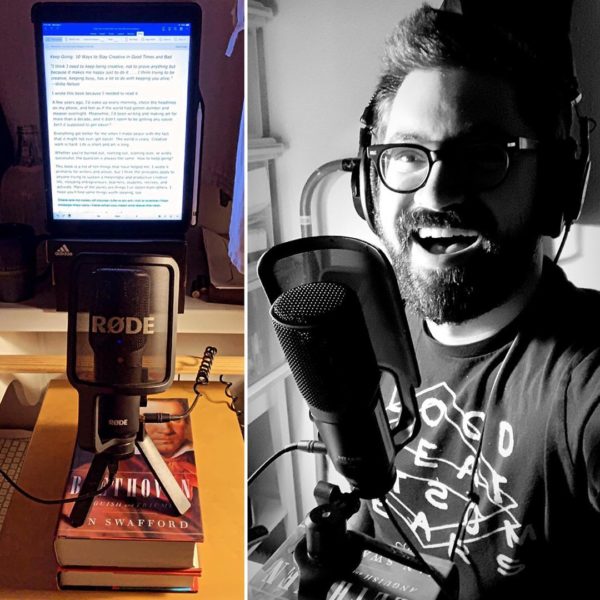
“People say to me, ‘I’m interested in doing audio books, what should I do?’ and I say, ‘Well, grab something at random, go sit in your closet and read out loud for 8 hours. And if you feel like doing it again tomorrow, give me a call.’”
—Scott Brick
This week I spent two days in my bedroom closet, recording an audiobook of the Steal trilogy for release on November 24th. Here’s how it went down:
First, I wrote a script, which required translating the highly visual books into something that worked as pure audio. (My wife suggested I listen to one of our sons’ copies of The Magic School Bus to come up with a good introduction. “Dear readers and listeners…”)
Once we had a script, we set a recording date, which was going to be at a local studio at first, but then I asked if we could do it at home. The engineers shipped me a laptop with recording software and a Rode NT USB mic. (A very decent condenser — I use an older dynamic Rode Podcaster down in my office.) I put down a rug on the floor of the carpet, and padded the walls with a few blankets and pillows. The laptop had a loud fan, so to cut down on noise, I put the laptop in our bathroom, and ran the USB cord to the mic under the closet door. (My boys were allowed to have their iPads downstairs all day as long as they promised not to make any noise. They complied!)
On the day of recording, I called my engineer and my producer on Zoom, shared my screen, and gave the engineer control of the computer so he could adjust levels and start and stop the recording. Once he had control of the computer, I stepped into the “booth” (closet) and put on my headphones, and all I had to do was read the script off my iPad. The engineer and the producer had the same script, so they could stop me and tell me when I screwed up, or suggest changes. We were doing all our actual communicating over Zoom, but the recording was happening locally on the machine in the bathroom. Very cool.
My producer and I were also able to make edits on the fly, with the engineer marking the changes in the script, so the final production guys will be able to cut the file together properly. (For example: I tried to say the word “ruminative” about two dozen times, until I just changed it to “reflective,” which sounded better anyways.)
The thing that slowed us down the most was looking up pronunciations for all the proper names that get mentioned in the text. (When I give a talk, I usually just let everyone know I’m a Texan and that gives me license to mispronounce everything.) Next time you need to figure out pronunciations, here’s a good list of places to look things up:
- Merriam-Webster.
- Forvo.
- YouGlish. (This is, perhaps, the most interesting of the sites — if you search someone’s name, they use the captions in YouTube to scrub to the parts of videos where people say the names. The only trouble is, several of the names I needed to know how to pronounce turned up videos of me speaking.)
It took us two days to get through 42,000 words, which I’m told isn’t too bad! I had two big revelations:
1. Recording is a physical process. It’s actually really hard work — it requires a ton of concentration and performance while sitting on your ass. My throat and my nerves were raw and I was an exhausted wreck at the end of the day! You start to notice every single weird pop and click your horrible mouth makes. I drank probably 3 gallons of water. (I was told, too late, that a green apple helps with mouth noise.)
2. You should record the audiobook before you turn in the book. I always read my work out loud when I’m editing, but being forced to say your words into a microphone and hearing your voice over headphones turns up every wart and wrinkle in the text. “What illiterate wrote this script?” I thought, five minutes into recording. The books got even better in the course of recording.
Anyways, this audiobook trilogy has been a long time coming, I had a lot of fun working on it, and I’m excited for y’all to hear it! To be the first to know when it’s ready for download, sign up for my newsletter.
